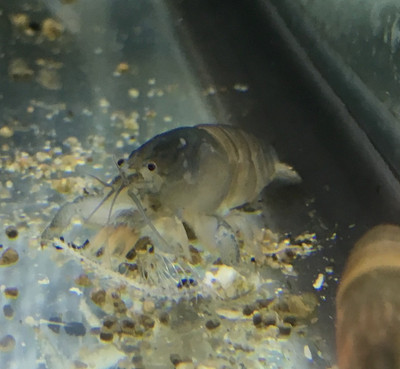Sunday Species Spotlight: African Vampire Shrimp (Atya gabonensis)
Posted by Crystal Chan on on 10th Jul 2022
African Vampire Shrimp (Atya gabonensis)
IUCN Conservation Status: Least Concern
Ecology
Despite its ferocious name and sharp claws, the African Vampire Shrimp is actually a very gentle and peaceful creature that can be kept with many other aquatic animals! Its native habitat ranges throughout West Africa, in the countries of Cameroon, the Democratic Republic of Congo, Gabon, Ghana, Liberia, Mali, Nigeria, Sao Tome and Principe, and Senegal. [1] There are some accounts of it being found in South America as well, but this is disputed.
Boasting colors that range from white-gray, to red, to bright blue, this shrimp makes a living in rocky, fast-flowing streams that can be found in West Africa’s wetlands. [1] This shrimp is also not fussy: it uses fan-like appendages to filter feed on passing material, including diatoms*, algae, and detritus* as it sits on rocks and other surfaces. [2]
Fishery
Because this shrimp is almost impossible to breed in captivity, the African Vampire Shrimp is caught in the wild by artisanal fisheries. A 2009 article reported that the fishery was seasonal from December through June/July in certain parts of Africa, and that it was caught using bamboo poles and artificial shelters. [3]
In Aquaria
Because it is so docile, this shrimp does well with most non-aggressive species. And although this shrimp does not breed in captivity, it can have a lifespan of up to 10 years with good care and can grow up to 4.5 inches in length. [4] It needs some water flow in order to feed well, and food should be finely ground–some resources even recommend feeding it with “green water”, which is tank water containing floating green algae. [4] So in a way, unlike other types of shrimp that are popular for cleaning up string algae, the African Vampire Shrimp cleans up detritus and free-floating particles in the water and can be a valuable tank cleaner.
Diatoms: single-celled algae that has a cell wall made with silica.
Detritus: organic matter or waste (i.e. fish poop!)
Citations
[1] De Grave, S. & Mantelatto, F. 2013. Atya gabonensis (errata version published in 2016). The IUCN Red List of Threatened Species 2013: e.T198241A107023029. https://dx.doi.org/10.2305/IUCN.UK.2013-1.RLTS.T198241A2517516.en. Accessed on 01 July 2022.
[2] Obande, R. A., & Kusemiju, K. (2008). Food and Feeding Habits of Atya gabonensis from Lower River Benue in Northern Nigeria. West African Journal of Applied Ecology, 13(1), 77–82. https://doi.org/10.4314/wajae.v13i1.40582
[3] Nwosu, F. M. (2009). Aspects of the Biology of the Gabon Shrimp Atya gabonensis, Giebel 1875 in the Cross River, Nigeria. Journal of Fisheries International Vol.4 Issue 4. https://medwelljournals.com/abstract/?doi=jfish.2009.58.61
[4] Michael. (n.d.). Vampire Shrimp – Detailed Guide: Care, Diet, and Breeding - Shrimp and Snail Breeder. Retrieved June 30, 2022, from https://aquariumbreeder.com/vampire-shrimp-detailed-guide-care-diet-and-breeding/

